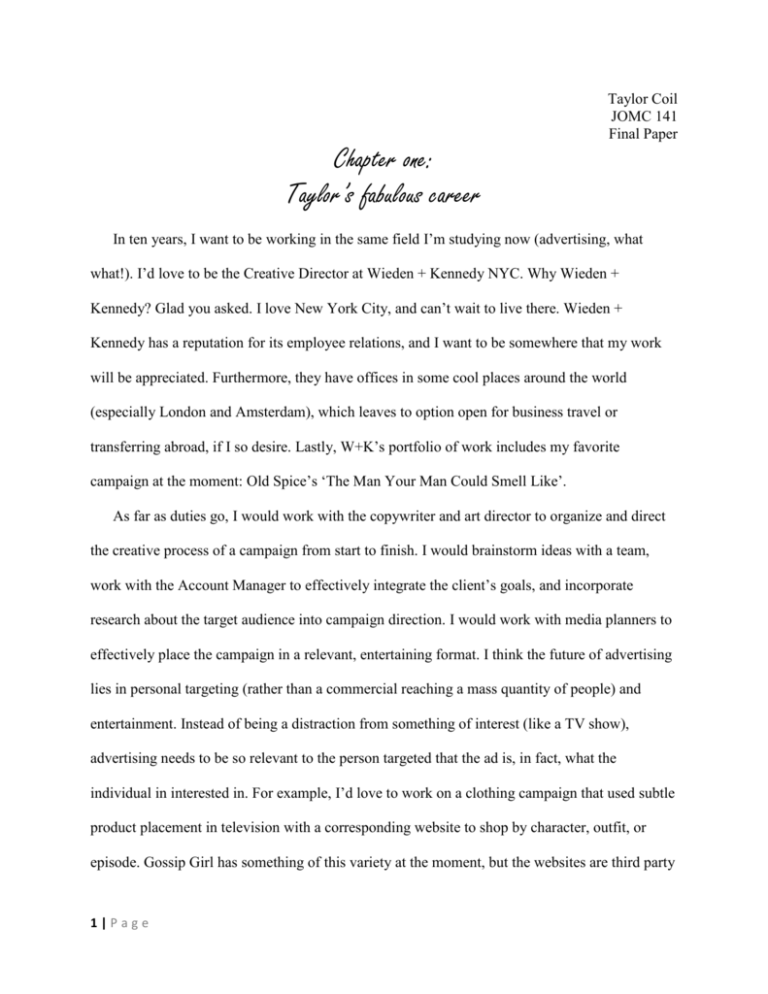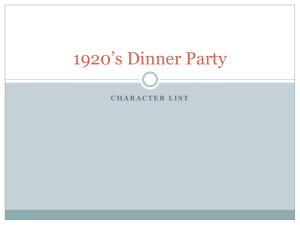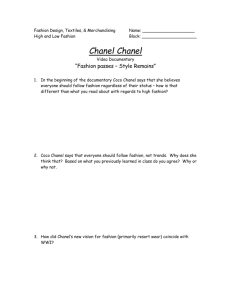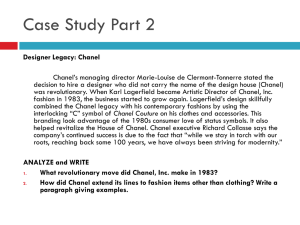Taylor Coil JOMC 141 Final Paper Chapter one: Taylor's fabulous
advertisement

Taylor Coil JOMC 141 Final Paper Chapter one: Taylor’s fabulous career In ten years, I want to be working in the same field I’m studying now (advertising, what what!). I’d love to be the Creative Director at Wieden + Kennedy NYC. Why Wieden + Kennedy? Glad you asked. I love New York City, and can’t wait to live there. Wieden + Kennedy has a reputation for its employee relations, and I want to be somewhere that my work will be appreciated. Furthermore, they have offices in some cool places around the world (especially London and Amsterdam), which leaves to option open for business travel or transferring abroad, if I so desire. Lastly, W+K’s portfolio of work includes my favorite campaign at the moment: Old Spice’s ‘The Man Your Man Could Smell Like’. As far as duties go, I would work with the copywriter and art director to organize and direct the creative process of a campaign from start to finish. I would brainstorm ideas with a team, work with the Account Manager to effectively integrate the client’s goals, and incorporate research about the target audience into campaign direction. I would work with media planners to effectively place the campaign in a relevant, entertaining format. I think the future of advertising lies in personal targeting (rather than a commercial reaching a mass quantity of people) and entertainment. Instead of being a distraction from something of interest (like a TV show), advertising needs to be so relevant to the person targeted that the ad is, in fact, what the individual in interested in. For example, I’d love to work on a clothing campaign that used subtle product placement in television with a corresponding website to shop by character, outfit, or episode. Gossip Girl has something of this variety at the moment, but the websites are third party 1|Page and not client-sponsored. Incredible opportunity lies in product placement, but it only works if the brand effectively contributes to the entertainment value of the program and makes sense with the characters and storyline. I have several reasons for wanting this position. First of all, I want to have creative license in whatever field I enter. Advertising seems a great fit, as it incorporates creativity into a business atmosphere. The industry is fast-paced and team oriented. In terms of workplace environment, advertising firms tend to be devoid of typical “desk-jobs”. A day in the life of a creative director begins with slipping into jeans and a casual shirt. A suit is only necessary when meeting with clients; creative juices flow better in a pair of dark-wash Sevens. I love the idea of being comfortable at work. In essence, it allows for individuality. A suit-and-tie workplace environment promotes the rise of the ‘organization man’, one willing to be a corporate puppet to get ahead. I don’t want to be in a place like that. I don’t want to feel the need to create a false image for myself and have my guard up all the time. The casual environment of advertising avoids such issues. It seems to be the ideal mix of professionalism, individuality, business, and creativity. Chapter two: Taylor’s code of ethics In my fabulous career as the creative director at Wieden and Kennedy, there are several major values which I will be absolutely unwilling to compromise. Fidelity and reparation, as dictated by Ross’ prima facie duties, are of vital importance. Truth must be the foundation of all communication, commercial or otherwise. In advertising, it is unquestioningly essential to present fair, complete information about the product being sold. This virtue is so important that it 2|Page almost speaks for itself. Branding based on false information is absolutely unacceptable; the brand must reflect the product qualities. Failure to do so is cheating the public. I won’t do that. In the event that I either make a terrible choice or accidentally present untrue or deceptive claims, I will always take action to remedy the situation. Obviously, the reparation will be specific to the circumstance. My rule of thumb will be to take any necessary step to fix the situation. Whenever possible, I’ll go one step further: contribute to society in a positive way. In my career, I will strive to uphold Ross’ prima facie duties of beneficence and noninjury. My goal should always be to fill a need in an individual’s life with the promotion of a product. Attempting to shove a product into areas (or markets) that do not contribute to the consumer’s happiness, well-being, or quality of life does not sit well with me. If helping people is not possible, I should at least aim to avoid injury to anyone associated with or affected by my campaign. Through advertising, I will always attempt to serve the best interest of society. I will not promote brands in a manner that is exploitative or unfair. I will not promote products that are unhealthy or inappropriate for the target audience. I will, however, help to uphold our capitalistic society through branding, product promotion, and marketing. Code of Ethics for Advertising Professionals: -Advertisements must convey truthful information. The omission of facts with significant bearings on the product is unacceptable. -All claims in advertisements must be backed with reliable, accurate evidence. -In a ‘slice-of-life’ style advertisement, the product should be portrayed in a reasonable and applicable manner. The consumer depicted should reflect an average user of the brand, and the activities portrayed must be reasonable for the consumer. 3|Page -In an advertisement featuring a testimonial, the consumer ‘testifying’ should be an actual brand user whose feelings towards the brand are accurately depicted. In addition, the testifier should portray an average user of the brand. -When comparing a product to a competing brand, all comparisons must be fair and accurate. Misleading claims that are ‘technically true’ are to be avoided. -A demonstration should feature the product as-is, without adjustment. It should be replicable among all copies of the product with similar results. -The target audience must be able to form educated purchasing decisions based on reliable information. The consumer must be able to identify the promotion as intentional persuasion. Therefore, targeting children is unacceptable. -Audiences should receive promotional materials regarding products that have the potential to better their everyday lives. Products that are detrimental in a major way should not be advocated as beneficial. -Advertisers should strive to provide relevant information to a given person. Advertisements should be applicable to the individual’s life, interests, habits, and purchases. -Advertisers should respect the privacy of consumers. When compiling information regarding past purchases, location-based technology, or otherwise, consent to use said information must be obtained. The consumer should be targeted willingly. 4|Page -When using product placement as part of a campaign, first priorities should be relevance and entertainment value. The advertiser should keep in mind that a television show does not exist to showcase products. Thus, media planners should select programs that are consistent with the brands image. Furthermore, product placement should contribute to the entertainment value, sense of realism, and character development of the program. Advertisers should not compromise the integrity of a television show to promote a brand. -The medium used in promotion should effectively touch the target audience without intentionally reaching vulnerable individuals (i.e. children). -Media usage should be unobtrusive, helpful, and informative. Chapter three: Taylor’s Dilemma The whole office is buzzing. We’ve just landed a big-time client: a new Chanel perfume. I’ve been named as the head of creative for the campaign. We’ve only just received confirmation of the job, and we’re already sipping champagne and talking strategy. My copywriter and art director can’t wait to get started. After a week of conversation with Karl Lagerfeld, the account planner fills me in on the details about the campaign. The perfume should uphold the sense of luxury and attainment that the name Chanel carries. It should be a symbol of envy, status, and sophistication. However, the target market for this particular product is 14 – 24 year old females. Our research has identified a competing product as Ralph by Ralph Lauren. Chanel wants to extend their market without sacrificing image, luxury, or status. Chanel perfume should not be associated with the average teenager. 5|Page My creative team and I start brainstorming ideas. We decide to focus on the dreams and fantasies of adolescent girls. We come up with a ‘representative’ for Chanel perfume, and create a storyline about her. Her name is Sophia; she is 22 and a recent graduate from a design college. She grew up in an upper-middle-class family in suburban Connecticut. She attended a private high school, drives a white Lexus, and owns several pieces of fine jewelry. She has recently moved to Paris to pursue a career in fashion. Sophia is a young version of the modern woman. She is tall, slender, bright-eyed, and beautiful. Her clothes are age-appropriate while maintaining unquestionable luxury. She wears mostly candy colors. A first impression of Sophia would be that she is sophisticated and well-off with a passion for life and a love for the urban environment. My ethical dilemma centers on society’s view of the ideal female. I am fully aware that images of women in the media, including advertisements, contribute to views of body image in girls. I want to maintain consistency with Chanel’s image, but I do not want to cause girls to feel self-conscious because they don’t look like Sophia. The dilemma begins in casting Sophia. Chanel traditionally uses Caucasian, high-fashion, editorial models. The girls are at least 5’10”, skinnier than some ballerinas, and have striking features. I am expected to use a model that upholds all of these ideals and make it work with Sophia’s storyline. Additionally, I will use only Chanel attire, makeup, and accessories in the shoot. This situation may sound fine to many, but there are a few small issues. Obviously, a 5’10” skinny white female is not representative of the audience to which I am advertising. Furthermore, societal ideals regarding the female form are unfair and detrimental. This fact must be carefully considered when marketing to adolescent girls, as they are ruled by hormones and are possibly the most insecure people in the world. I do not respect the fact that society defines the ideal figure so narrowly; teenagers and young women are molded to believe that is what they 6|Page should strive to look like. I definitely don’t want to contribute to that image. I also understand that Chanel is a symbol of attainment, and sporting the logo inspires envy. This is particularly true among the target audience. When I was 16, I wanted to be seen wearing the right brands at all times. The idea of simply owning something Chanel, even if it wasn’t my style, was exciting to me. Reinforcing blind label choice is something I want to avoid. Chapter Four Taylor’s reasoning For this section, I will use two different ethical ‘tests’ to reach a solution to my ethical dilemma: Sissela Bok’s model and the Potter Box. Sissela Bok’s Model: 1. Consult my conscience. I feel okay about using a model for Sophia similar to those traditionally used by Chanel if certain circumstances are met. I don’t like the idea of highlighting her thinness, height, or striking beauty. Minimizing that aspect of the model will ease my distaste, because I will feel less responsible for the ideal image presented. My gut tells me to present an editorial spread that is artsy, tasteful, and sophisticated rather than vulgar or revealing. 2. Seek expert advice. In this case, since I am not yet connected enough in the advertising world to have a trusted ad mentor, I’ll use my ol’ bud Aristotle. Aristotle valued individual goodness and potential over society as a whole. He would recommend highlighting Sophia’s moral and admirable traits rather than her physical beauty. Aristotle would suggest presenting a model worthy of respect, someone that inspired consumers to achieve their full potential. 7|Page 3. Conduct a public discussion. I’ll invite Karl Lagerfeld, a 14-year-old girl, her mother, a 20-year-old girl, other perfume manufacturers, magazine editors, a couple of models, the photographer, and my creative team. Karl Lagerfeld will present the priority of maintaining the Chanel image. He will want to do whatever it takes to ensure Chanel is always viewed as sophisticated, luxurious, and tasteful. The 14-yearold girl will want a perfume that is distinctive and recognizable as Chanel. She will want to be the envy of her friends because she is sporting a designer label. Her mother will be concerned with price and taste; she will not want her daughter wearing an expensive perfume that smells like a baby prostitute. The 20-year-old girl will want to ensure sophistication and societal image. She would not buy a perfume that can be sniffed in middle schools everywhere; a 20-year-old wants something that is youthful and adult at the same time. Other perfume manufacturers are concerned with quality and pricing; they want to maintain the luxury of the industry. Magazine editors want to ensure that the advertisement fits with the image of their publication; for instance, Sophia should not look out of place in Vogue. Models will want to voice their concerns with a campaign, but who knows what will come out of a model’s mouth. Surely not me. The photographer will want to make sure the advertisement is artistic and within his or her style. My creative team will present a similar argument as the photographer, also presenting reasonable parameters for what they can accomplish. The Potter Box 1. Define the ethical dilemma. I must create an ad campaign that is consistent with the Chanel brand while staying true to my morals. Specifically, I need to depict a successful, 8|Page high class, skinny, beautiful young woman. However, I do not want to contribute to a skewed societal ideal and promote insecurity among adolescent girls. 2. Identify my values applicable in the situation: a. Modesty, individuality, nonconformity, truth, inner beauty, drive, passion, equality, maturity, age appropriateness, sophisticated taste, constant individual growth, beneficence 3. Identify the principles. Aristotle, as stated in the Bok analysis, values individuality over society. Plato, on the other hand, would want the priority of the campaign to be maximizing societal well-being. Hobbes would advocate social control with the advertisement, and would probably take little issue with conformity. So: the principles are individuality, societal well-being, and social order. 4. Choose loyalties. As an advertiser, I am loyal to my agency (Wieden + Kennedy). Their values must be reflected in my campaign. I am also loyal to my client, Chanel. By accepting the campaign, I must comply with Chanel’s wishes to maintain their image. I cannot do anything drastically differentiated from what Chanel is known for. The introduced product has to fall within the Chanel brand effectively. I am loyal to myself. I cannot spearhead a campaign that is completely against what I stand for. Lastly, I am loyal to society (specifically, the target audience). I need to present an image that is beneficial to a consumer. When a 16-year-old girl looks at the advertisement, she should not feel insecure or self-conscious. Instead, she should be intrigued by the spread and feel compelled to try the perfume because it makes sense with who she is. I do not want the girl to feel the need to change her image to fit Chanel; Chanel should fit with her. 9|Page So here’s what I did. I used the tall, skinny model. Sophia is not fair skinned, blue-eyed, and blonde, but racially ambiguous. Her clothing is tasteful, modest, youthful, and high fashion. The artistic touch is subtle. Sophia is positioned in urban Paris wearing a light pink sundress and a white cardigan with the Chanel logo. Paris is stormy and grey. Sophia is standing on a sidewalk surrounded by modernist Parisian architecture, turned at a 45 degree angle to the camera. Her arms are back, her black umbrella is strewn on the ground (she doesn’t seem to need it), her eyes are pointed up, there is a slight smile on her lips, and it looks as though she is embracing the rain. She looks youthful, but sophisticated enough for a casual workplace environment. The breeze blows her hair back, and a young man with an umbrella turns his head towards Sophia. She seems to glow, lighting up her immediate surroundings with her energy. The spread is ethereal, charming, and sophisticated. The tagline reads, “Carpe Diem. Carpe Chanel Mademoiselle.” (I have decided the name of the perfume is Chanel Mademoiselle… Lagerfeld liked me so much in our public discussion that he let me name it!) There is a picture of the perfume bottle in the lower right hand corner. I include a peel-off miniature sample of the fragrance on the right edge, so that the product is showcased and not merely personified. In this respect, I have attempted to maintain the Chanel image while promoting individuality and spirit among girls. Hey, I’m pretty proud of myself. This sounds like an interesting spread. Maybe I should go into advertising. Well, Temple, it’s been fun. I hope to see you around the thrill this summer / next year! Stay classy, keep your dancing shoes on, and always tell your classes stories. It makes for fun times. Peace! 10 | P a g e




